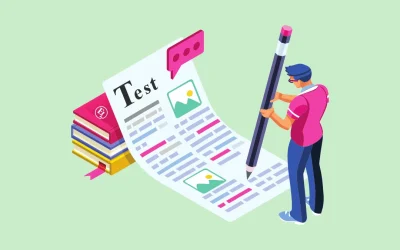That’s all well and good if you can afford to outsource professional designers. But what if you can’t? Even then, you can create a professional-looking brand on a budget using a templates as a starting point. Is it even possible? Yes, with the right tools and approach, you can achieve a polished brand identity without breaking the bank.
Foolproof brand design tips for small businesses
Luckily, you can put your struggles behind you because you no longer have to sacrifice your brand’s design because cash is tight. All you need are a few brand design tips for small businesses that won’t empty your pockets. And guess what? That’s exactly what we have for you.
Design your brand around your target audience
Your brand exists to serve your target audience, meaning you have to design it around them to sell to them. You achieve that by defining who they are and then defining your brand to suit.
Your first step for creating a brand that consumers relate to is building a customer persona to understand your audience. This is where market research comes into play, and all it costs you is time.
You figure out who your target audience is by researching the platforms they use when searching for brands in your market, their demographics, such as age, gender, location, education, and employment, and discovering their pain points, the what and why they need a brand like yours.
When you discover who your target audience is, it will guide your branding strategy, resulting in a brand people will organically gravitate towards and trust. And those are things money can’t buy.
You can use these tools to help you discover your target audience:
- Keywords Everywhere: It’s a free keyword research tool that provides CPC information on a chosen keyword and its search volume. It’s an excellent way to uncover which keywords your audience use when searching for your products or service.
- Facebook Analytics: Provides numerous demographic information pertaining to your current customers.
- Social Mention: Tells you when your brand is mentioned, and across 100 social media networks, so you know how customers perceive your brand.
- Statista: Provides invaluable statistics in graph form on over 600 industries.
Developing your brand identity and voice can save you money
One of the most important brand design tips for small businesses is defining your brand identity and voice. Once you’ve identified your target audience, it’s time to establish a strong brand identity so you stand out from your competitors.
When you create your brand identity, you give it a voice, the tone you’ll use to communicate with your public. Your tone consists of your brand values, goals, what they represent, and ultimately how people will feel when they first see your brand.
Give your tone of voice some thought and what it is you want your brand to say. If you’re in a professional market, then you should use a sincere and authoritative voice; on the other hand, if you’re an outdoor adventure brand, then your tone would be exciting and rugged.
Once you have your tone, create content that supports it. Such as your blog, emails, social media, and web content, as the secret to a brand voice that gets its message across is consistency.
Build a high UX website cheaply
Gone are the days when you had to mortgage your house to build a high UX website because now you create a drag and drop website and build one relatively cheaply.
And these sites enable even the most technically challenged business owners to build one in a matter of days, and depending on the size you need, even hours. Making them the perfect solution for businesses on a budget.
Here are four sites that can make your brand look like it invested heavily in your website design:
- Simbla: If your business has technical needs, this is an excellent choice with an online database and integrated application.
- Weebly: An easy-to-use platform that offers highly responsive web design.
- Strikingly: If all you need is a clean-looking landing page with a CTA (call to action), Strikingly provides a polished, optimized, single-page design.
- Wix– You’ve probably heard the name before, and for a good reason. There’s not much you can’t do with their intuitive interface, and their customer support is legendary.
Create a logo design brief
A logo design brief traditionally outlines the fundamentals about your business that you’d provide a designer, including elements such as market, target audience, and logo style.
Logos are an essential element in branding because they’re a visual that instantly connects with our emotions and can create cohesion throughout your marketing platforms. So much so that large corporations spend tens of thousands designing theirs to ensure their brand is instantly recognizable and stays in the viewer’s memory.
However, you can cut out the expense of hiring a logo designer and instead use a logo creator, you can create a professional logo at a fraction of the price – usually about $20.
These innovative AI machine learning tools can create market and consumer-relevant logos in minutes. All you have to do is answer niche-related questions and then click and drag until you have the one you feel represents your business. You can try this using free logo maker tools.
Use visuals with your branding
90% of information transmitted to our brain is visual, and we process them 60,000X than written content. It’s why visuals are now the driving force behind successful brands, and social media platforms like Instagram enable brands of all sizes to use them for their marketing campaigns.
Visuals create the look and feel of your brand, and your goal is to use ones that match your tone of voice.
You find the right visuals for your brand by creating a brand style guide. A brand style guide is an excellent way of bringing all the visuals you’ll be using together, ensuring they suit and complement one another. Elements you should include are your logo, color palette, infographics, photography, and video.
If you already have a website, ensure any visuals you’ve chosen complement it, as your site is often your leading business real estate, so your overall marketing look has to be consistent with your shop front.
Starting a blog is a great investment
Not everyone’s a born writer, and most of us don’t give blogging much thought. But it’s well proven that a blog can be hugely beneficial to a brand, especially one on a budget, as all it costs you is time. That’s why you will it’s good to learn the basics of good small business blog writing yourself. But if you don’t have the time or blogging isn’t your forte, you can outsource at an affordable price.
Paying for traffic using ads and using high-tech conversion strategies aren’t cheap, so one of the most beneficial brand design tips for small businesses is driving traffic on your website by writing relevant, helpful content over advertisements every time.
Create valuable content and reap the rewards
Content, however, goes beyond your blog.
Content marketing is still the driving force behind the internet and everything on it, especially when building a brand. It provides you with a golden opportunity to establish yourself as an industry expert and go-to resource in your marketplace.
When you achieve that, people will trust you and choose your brand before your competitors.
The key to a successful content marketing strategy is creating relevant and helpful content that your target audience needs. It also comes back to our earlier tip relating to your brand voice and using it throughout your content, as this reinforces who your brand is, why you exist, and how you can benefit your audience.
Social media is free, use it to your leverage advantage
Social media is an essential brand design tip for small businesses on a tight budget. It’s because social media has quickly stepped forward and become a leading platform for brand marketing. There are numerous ways to use it to increase your brand awareness, run marketing campaigns and connect with your target audience.
Such as affordable Facebook ads that specifically target your audience’s demographic, encouraging people to like and share your brand posts and product images, and using links to connect your visuals to your website.
And now, there are free tools that enable you to consistently promote your brand and interact in real-time with your customers. Like a social media manager that automates your scheduling calendar and plans your post-release times on all your social channels, ensuring you post at the times your audience is most active.
Conclusion
There are amazing brand design tips for small businesses that will only cost your time. Being curious about new trends, learning new skills, and improving your knowledge is “the secret” behind the success of your small business. Knowing you have to be the man behind everything might sound overwhelming at first, but implementing these tips will make the process easier and entertaining.
More must-read stories from Enterprise League:
- The only list of novels for entrepreneurs that you will ever need.
- Boost foot traffic and sales in your brick and mortar business.
- Implement a CRM strategy for your business using this guide.
- Golden rules about Google advertising for small businesses.
- Warning signs of a terrible boss that everyone must be aware of.
Related Articles
10 business tips for beginners to help you build a healthy brand
Starting a business can be quite the challenge especially if you’re all new to entrepreneurship. These business tips for beginners will help you set off on the right foot.
SEO writing: Five foolproof tips to secure you the first page
When it comes to SEO writing it’s more guessing and less evidence about what works and what doesn’t. Luckily, we know what can really help you reach the first page.
How to onboard a new employee: Tips for quick integration
Your guide to smoother employee onboarding where you will find practical strategies that help new hires feel welcome and become productive team members faster.
10 business tips for beginners to help you build a healthy brand
Starting a business can be quite the challenge especially if you’re all new to entrepreneurship. These business tips for beginners will help you set off on the right foot.
SEO writing: Five foolproof tips to secure you the first page
When it comes to SEO writing it’s more guessing and less evidence about what works and what doesn’t. Luckily, we know what can really help you reach the first page.






